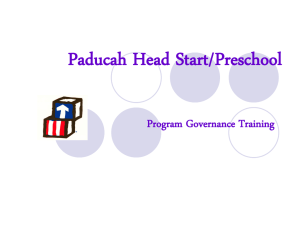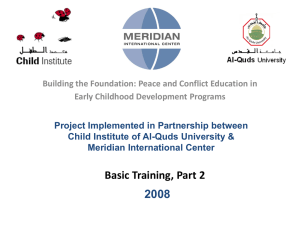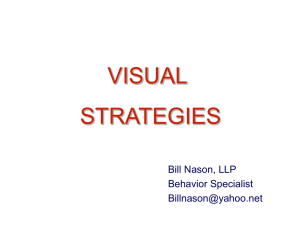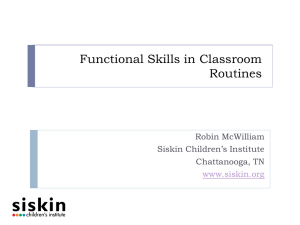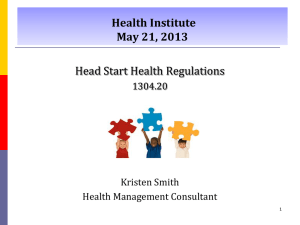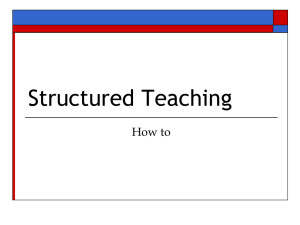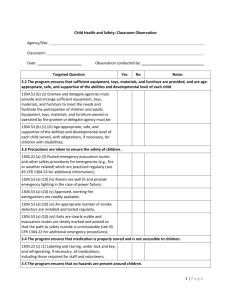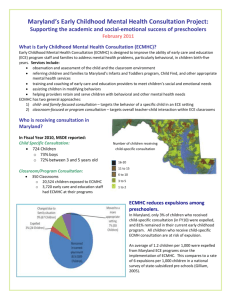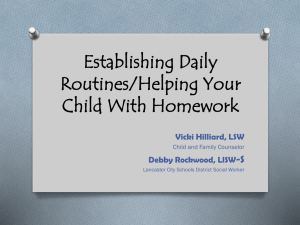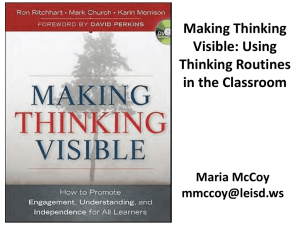What Works: Using Evidence and Practice
advertisement
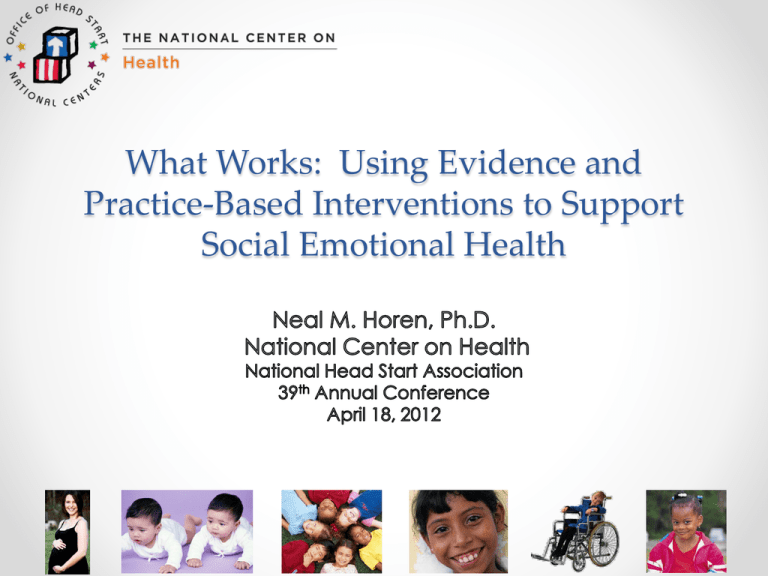
What Works: Using Evidence and Practice-Based Interventions to Support Social Emotional Health The Head Start Act • Comprehensive health, educational, nutritional, social, and other services needed to aid participating children in attaining their full potential, and to prepare children to succeed in school Healthy Children Ready To Learn • In a comparison of school readiness outcomes for Head Start children and eligible children on the wait list o The Head Start children scored significantly better in School Readiness measures o Parent reports of health outcomes also showed significant differences between the 2 groups with the Head Start 1 families group reporting more healthy responses ACE Study: Major Findings Increases in ACE score associated with increased risk for the following health problems: • • • • • • • Alcoholism and alcohol abuse Chronic obstructive pulmonary disease (COPD) Depression Fetal death Health-related quality of life Illicit drug use Ischemic heart disease (IHD) • • • • • • • Liver disease Risk for intimate partner violence Multiple sexual partners Sexually transmitted diseases (STDs) Smoking Suicide attempts Unintended pregnancies FACES data • Parents o Majority of parents do not report depressive symptoms o About 40% report some symptoms, 19% report moderate symptoms • Staff o Majority of HS teachers do not report depressive symptoms, about 1/3 report some symptoms o 16% report moderate to severe symptoms Surgeon General’s Vision for Children’s Mental Health Prevention • Project Head Start • Carolina Abecedarian Project • Infant Health and Development Program • Elmira Prenatal/Early Infancy Project • Primary Mental Health Project • Other Prevention Programs and Strategies Head Start Performance Standards Early Childhood Health and Development Services 1304.20 Child Health and Development 1304.21 Education and Early Childhood Development 1304.22 Child Health and Safety 1304.23 Child Nutrition 1304.24 Child Mental Health 1304.21(c)(1)(iii-vii) • Integrates all educational aspects of the health, nutrition, and mental health services into program activities; • Ensures that the program environment helps children develop emotional security and facility in social relationships; • Enhances each child's understanding of self as an individual and as a member of a group; • Provides each child with opportunities for success to help develop feelings of competence, self-esteem, and positive attitudes toward learning; and( • Provides individual and small group experiences both indoors and outdoors. Head Start Performance Standards Mental Health 1304.24 (a) (1) Work Collaboratively with Parents 1304.24 (a) (2) Must Secure the Services of Mental Health Professionals. to enable the timely and effective identification and intervention in family and staff concerns about a child’s mental health 1304.24 (a) (3) must include a regular schedule of on-site mental health consultation Where and When Do You Integrate Social Emotional Well Being into Your Work? Teachable Moments for Social Emotional Well Being Activities • • • • • • • • • Art Activities Behavior Management Blocks and Table Toys Circle Time Clean Up Time Cooking Dramatic Play Field Trips Home Visits • • • • • • • • • Large Motor Play Meals Music and Movement Outside Time Parent Meetings Quiet/Nap Time Sensory Play Materials Staff Training Transitions Work Collaboratively with Parents • The Head Start Parent, Family, and Community Engagement Framework o Children will: • Engage and maintain positive adult-child relationships and interactions • Engage and maintain positive peer relationships and interactions • Display levels of attention, emotional regulation, and behavior in the classroom that are appropriate to the situation and supports available • Learn and internalize classroom rules, routines and directions • Develop and display a sense of self, confidence in their abilities and a strong identity that is rooted in their family and culture. -NCQTL Culture • "Each baby is born into a unique family that has its own culture and history, its own strengths and its own way of coping with stress and adversity." Parlakian & Seibel, 2002 My Culture • Small group activity Supporting Resilience • Help build a positive vision of future. • Affirm your support. • Help the family develop a plan to reduce effects of external stressors. • Evaluate which stressors are producing the most disruption of family interaction and routines. • Facilitate identification of resources and strategies to reduce the impact of stressors. • Identify family and other natural supports. CSEFEL Pyramid Model Goal: To Strengthen the Capacity of Head Start and Child Care to Promote the Social and Emotional Foundations of Early Learning Communication • Strong, clear communication strengthens partnerships. How we communicate with families both verbally and non-verbally sets a tone for how partnerships develop. 1304.24 (a) (3) • Mental Health Consultation ECMH Consultation • Indirect mental health intervention for infants, toddlers and preschoolers • Focused on young children in ECE settings and their caregivers • Collaboration between a professional consultant with mental health expertise and consultees 1910 Types of ECMHC • Child/family-centered consultation: Focuses on a particular child with challenging behavior and/or the family of that child • Programmatic consultation: Focuses on a general program or classroom issue that impacts the mental health of staff, children and/or families Cohen & Kaufmann, 2000 2011 Common Goals of ECMH Consultation • Reduce the impact of mental health problems among young children in ECE settings • Build the capacity of ECE staff, programs, and families to promote young children’s healthy social/emotional development and address challenging or troubling behaviors 2112 What ECMHC “Isn’t” • • • • • • Formal diagnostic evaluations Therapeutic play groups Individual therapy Family therapy Staff therapy Family support groups CSEFEL Pyramid Model: Promoting Social Emotional Competence in Infants and Young Children Breaking it Down: Nurturing Relationship “an enduring emotional bond to one or two specific people in whose presence I feel safe to explore new activities, ideas, feelings, and to whom I want to return when stressed.” http://ecmhc.org/temperament/index.html http://ecmhc.org/baby_books.html High Quality Supportive Environments What Would You See Happening? Talk at your tables and come up with one or two examples of what “Quality Supportive Environments” look likeput your post it on the flip chart CECMHC Resources for Quality Supportive Environments • • • • • Infant Family Posters Infant Staff Posters Toddler Family Posters Toddler Staff Posters Preschool Posters Putting it Into Practice Where do you see these tools fitting into your training and coaching work? Targeted and Intensive Supports CECMHC Resources for Targeted and Intensive Intervention Let’s Observe- Michael a Toddler Walking Through the Process Let’s Reflect for Michael What Does Social Emotional Development Look Like As Children Enter School? • • • • • • • • A sense of confidence and competence Ability to develop good relationships with peers and adults/make friends Ability to persist at tasks Ability to follow directions Ability to identify, understand, and communicate own feelings/emotions Ability to constructively manage emotions Development of empathy What happens when children don’t have these skills? Emotional Literacy …the ability to identify, understand, and express emotions in a healthy way 38 “If a child doesn’t know how to read, we teach.” “If a child doesn’t know how to swim, we teach.” “If a child doesn’t know how to multiply, we teach.” “If a child doesn’t know how to drive, we teach.” “If a child doesn’t know how to behave, we……..... ……….teach?………punish?” “Why can’t we finish the last sentence as automatically as we do the others?” – Tom Herner (NASDE President ) Counterpoint 1998, p.2 So. . .How do we teach it? • What are you doing now? Use Songs and Games Sample Song • If you are happy and you know it…add new verses to teach feelings – – – – – If you’re sad and you know it, cry a tear.”boo hoo” If you’re mad and you know it, use your words “I’m mad” If you’re scared and you know it ask for help, “help me” If you’re happy and you know it, hug your dad If you’re tired and you know it, give a yawn. Jim Gill “I’m So Happy I Could Growl” 41 How Schedules and Routines Support Social and Emotional Development • Schedules and Routines: o are an important part of each day o meet children’s basic needs o provide opportunities for learning and development o provide predictability, help infants and toddlers learn what to expect (from people and the environment) o help children develop a sense of security and control o support competence and confidence How to Structure Schedules and Routines to Support SE Development and Prevent Challenging Behavior • Schedules o o o o o Have a consistent schedule Minimize transitions Prepare children when there will be a change Use visual cues if children need them Create opportunities for “playing” with your child • How to Structure Schedules and Routines to Support SE Development and Prevent Challenging Behavior Routines Structure routines so they have a beginning, middle, and end Make them fun!!!!!!!!!!! Teach children the expectations of the routine Use visual cues if needed Involve children in daily routines such as preparing a meal or provide them with something to do o Use routine activities to strengthen relationship with your child o Use routine activities to teach new skills o Prepare children for transitions o o o o o First Then Wash hands Snack Visual Schedules 46 1. Turn on water. 3. Get soap. 2. Wet hands. 4. Rinse hands. 49 5. Turn off water. 6. Dry hands. 7. Throw away towel. 8. Go play. 50 Children with a Strong Foundation in Emotional Literacy: • tolerate frustration better • get into fewer fights • engage in less destructive behavior • are healthier • are less lonely • are less impulsive • are more focused • have greater academic achievement 51 Direct Teaching of Feeling Vocabulary 52 Enhancing Emotional Literacy • • • • • • • Direct Teaching Indirect Teaching Use of Songs and Games How would you feel if…? Checking In Feeling Dice and Feeling Wheel Use of Children’s Literature The tippy top of the Pyramid What a Licensed Mental Health Professional Does • Parent-Child Interaction Therapy • Child-Parent Psychotherapy • Dyadic therapy Promote staff wellness so that they can provide support to children and families in Head Start programs. • Taking Care of Yourself http://ecmhc.org/relaxation.html Knowing Your Stressors • What is stress? • What causes me stress? • What are some ways you deal with stress? RELAX • A good end to the day Healthy and Read to Learn Neal M. Horen, Ph.D. horenn@georgetown.edu This document was prepared under Grant #90HC0005 for the U.S. Department of Health and Human Services, Administration for Children and Families, Office of Head Start, by the National Center on Health.

